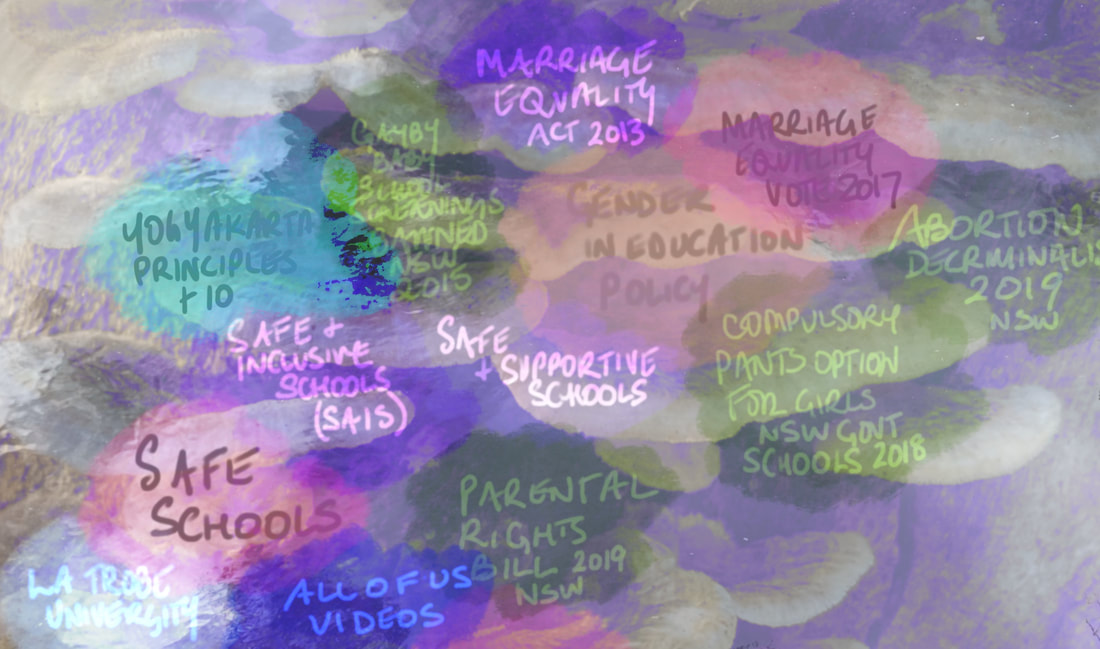|
They* begin searching for gender in the Australian Capital Territory (ACT) and New South Wales (NSW) education policy libraries. They are surprised and not surprised by what they find, or don’t find: in NSW gender is only cursorily mentioned, an absence or erasure of gender; in the ACT, an embedded presence. The contrast between these two jurisdictions is stark and interesting: geographically connected, with the ACT located literally inside, surrounded by NSW; but culturally, philosophically distant. There is a national curriculum and national education standards, yet each Australian state and territory has an education authority that develops its own policies. Both jurisdictions’ policies aspire to create safe and supporting learning environments for all students. The ACT’s Safe and Supportive Schools policy is contextualised with reference to federal and territory legislation and education policy frameworks, and explicit in requiring schools to deliver on these aspirations ‘creating, evaluating and maintaining a safe, respectful and supportive school environment’ that includes a ‘social and emotional learning approach’ and ‘restorative [as well as] disciplinary measures’. Gender appears in the policy definition of diversity ‘about active support and celebration of difference’, and with schools responsible for ‘developing processes and procedures address bullying, racial, sexual, homophobic, transphobic and other forms of harassment and violence’, with ongoing evaluation of their impact.
In NSW the education policy landscape is more fragmented and harder to navigate. They find that the Student Welfare policy has comparable aspirations and objectives to the ACT’s Safe and Supportive Schools but does not make the link to legislation. Issues of discrimination are sectioned off to the department’s Rights and accountability framework. Gender equity makes an appearance in the Student Welfare objectives of Effective learning and teaching to ‘ensure that gender and equity issues are recognised and addressed across the curriculum’ and as Positive climate and good discipline, ‘valuing difference and discouraging narrow and limiting gender stereotypes’, although how these are implemented is not specified so this seems to fall to individual schools to determine. Gender is absent in NSW’s Access and Equity grouping of policies which address anti racism, Aboriginal education and multicultural education, a Statement of commitment to students with disabilities as well as support for students with learning difficulties, high potential and living in out of home care. They wonder what’s going on in NSW and the ACT, and how these distinct policy approaches materialise in the everyday lived experience of students in schools? They take up Glenn C. Savage's concept of education policy as an assemblage in which policy is mobile, messy, incoherent and subject to deterrritorialisation and reterritorialisation, and add Stephen J. Ball's idea that policy becomes through contested dynamic processes of interpretation and reinterpretation (p. 389). Then thinking with Karen Barad, of gender in education policy as an ‘entangled web of phenomena’ (p. 388), they begin gathering events to map ‘specific entanglements of the multiple material-discursive apparatuses of bodily production [that might hint] at how they are entangled in space and time’ (Barad, 2021, p. 136). They know that this mapping can only ever be partial as the process of analysis itself cuts into and intra-acts with the dynamism of phenomena. Nevertheless, they follow threads of relation as they emerge in awareness, affect and form connections in this ’thick now’, paying attention to what’s produced and what’s excluded in the doing. In this in progress mapping, gender in education policy becomes entangled with developments in international human rights law principles to ensure freedom from persecution for people on the grounds of gender identity and sexual orientation, an education program designed to ensure schools are safe protect gender and sexuality diverse students by changing school cultures, ACT marriage equality legislation subsequently voided by the High Court, the banning of a documentary film in NSW schools, the election of Australia’s first openly gay head of Government in Australia, the Marriage Equality vote, a campaign to allow girls to wear pants to school, young queer, trans and non-binary activists and spokespeople Carter Smith, Georgie Stone and Audrey Mason-Hyde, Family Court decisions effecting trans youth in 2013 and 2017, South Australian gender recognition legislation separating sex and gender identity, a vocal South Australian conservative senator, the election of a NSW minority conservative senator as chair of the education committee and the NSW Parental Rights Bill, and, and… These events, part of a constellation of forces that constitute the phenomena of gender in education policy, suggest how gender might come to matter differently in student lives in the ACT and NSW. * I have chosen to write this blogpost in 3rd person. I identify as female and use she/they pronouns. I have chosen to use the pronoun 'they' in this post to trouble the assumption of binary gender.
0 Comments
Leave a Reply. |
BlogMy thinking about filmmaking as an affective, emergent mode of inquiry to explore experiences of gender in secondary school with young people through my doctoral research. Archives
December 2022
Categories
All
|
